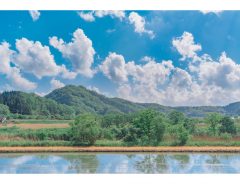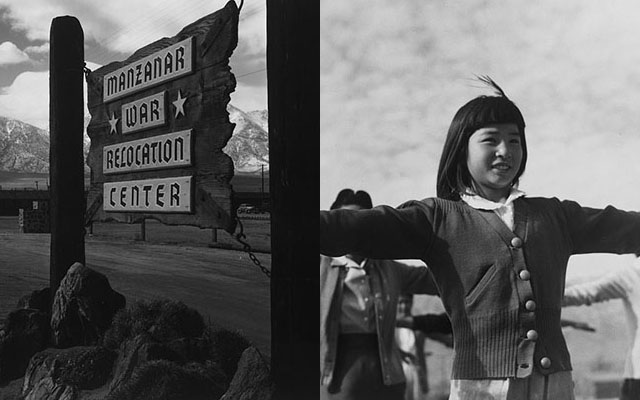- Source:
- Densho Encyclopedia / Library of Congress
- Tags:
- Ansel Adams / Manzanar / Photography
Related Article
-

Japanese Deer Rejecting Crackers After Eating Too Much Over Holiday Is Surprisingly Cute
-

Photographer explores Japanese countryside with shots that look like anime stills
-

Photographers Capture Stunning Otherworldly Sea Of Clouds In Japan
-

Japanese Rock Balancing Artist’s Masterpieces Appear To Defy The Laws Of Gravity
-

The Best Wildlife Photography Of 2015
-

Photographer’s Stunning Pictures Of Snow Blanketed Kyoto Will Spirit You Away



As hostility grew toward Japanese Americans in the United States during the advent of World War II, the U.S. government put forward a plan that would enable the War Department to exclude any person from predetermined military zones. This was known as Executive Order 9066, and was signed by President Franklin D. Roosevelt on February 19, 1942.
Following the signing of the order, somewhere between 110,000 and 120,000 Japanese-Americans were relocated and detained in “reception centers” on the west coast, with 9,837 detainees housed at the most famous of the camps, Manzanar.
Source: Library of Congress/Ansel Adams
The internment camp was closed off and secured by armed guards, manned security towers, and barbed wire. Most notable were the living conditions within the walls, which were famously far less than adequate. Manzanar was built rather hastily, and because of this it lacked proper medical supplies, and forced detainees to deal with communal outhouses, small living quarters, and barracks that did not adequately protect detainees from the elements.
Source: Library of Congress/Ansel Adams
Source: Library of Congress/Ansel Adams
Source: Library of Congress/Ansel Adams
Ansel Adams, one of America's most prolific photographers, visited the camp and documented the camp and those interned there in a series of photographs. Struck by the grave tragedy of the situation, he also found himself surprised by the strong sense of community within its walls. When handing over the photographs to The Library of Congress, Adams stated that "The purpose of my work was to show how these people, suffering under a great injustice, and loss of property, businesses and professions, had overcome the sense of defeat and despair by building for themselves a vital community in an arid (but magnificent) environment....All in all, I think this Manzanar Collection is an important historical document, and I trust it can be put to good use."
The true narrative here is the insensitivity and disregard for human life that led to this tragic event, but the observation that Adams makes is something worth shining a light on. The term "Japanese spirit" is an expression used quite readily when describing the camaraderie and resilient attitude with which Japanese people have historically responded to adversity (most famously national disasters such as earthquakes and tsunami). It also has roots in the term Yamato-Damashii, while which can have much different connotations today, reflects that spirit of resolve.
This photograph series allows a look inside the walls of Manzanar, and while it would be a failure of due diligence to gloss over the history of the camp, the following photos perhaps articulate the aforementioned attitude of strength and communal harmony in the face of extremely hard times.
Baseball
Source: Library of Congress/Ansel Adams
Volley Ball game
Source: Library of Congress/Ansel Adams
Calisthenics
Source: Library of Congress/Ansel Adams
People leaving Buddhist church, winter
Source: Library of Congress/Ansel Adams
Science lecture
Source: Library of Congress/Ansel Adams
Mrs. Ryie Yoshizawa, teacher, fashion designing class
Source: Library of Congress/Ansel Adams
Dressmaking class
Source: Library of Congress/Ansel Adams
Roy Takano, town hall meeting from side
Source: Library of Congress/Ansel Adams
Richard Kobayashi, farmer with cabbages.
Source: Library of Congress/Ansel Adams
Nurse Aiko Hamaguchi, Harry Sumida and Michael Yonemetsu in hospital
Source: Library of Congress/Ansel Adams
Bridge game, Nurse Aiko Hamaguchi, Nurse Chiye Yamanaki, Miss Catherine Yamaguchi, Miss Kazoko Nagahama
Source: Library of Congress/Ansel Adams
Children at Sunday school class
Source: Library of Congress/Ansel Adams
Children at Sunday school class
Source: Library of Congress/Ansel Adams
In biology class, high school, Kiyo Yoshida, Lillian Wakatsuki, Yoshiko Yamasaki
Source: Library of Congress/Ansel Adams
Mr. Matsumoto and group of children
Source: Library of Congress/Ansel Adams
Pool in pleasure park
Source: Library of Congress/Ansel Adams